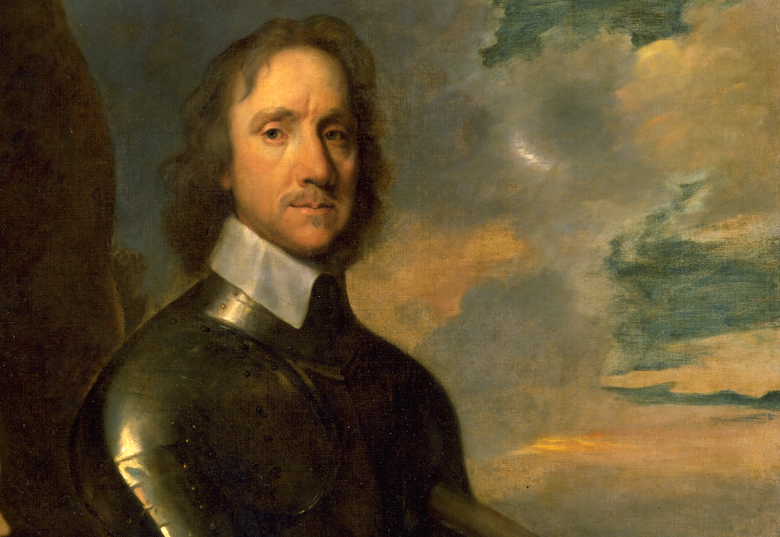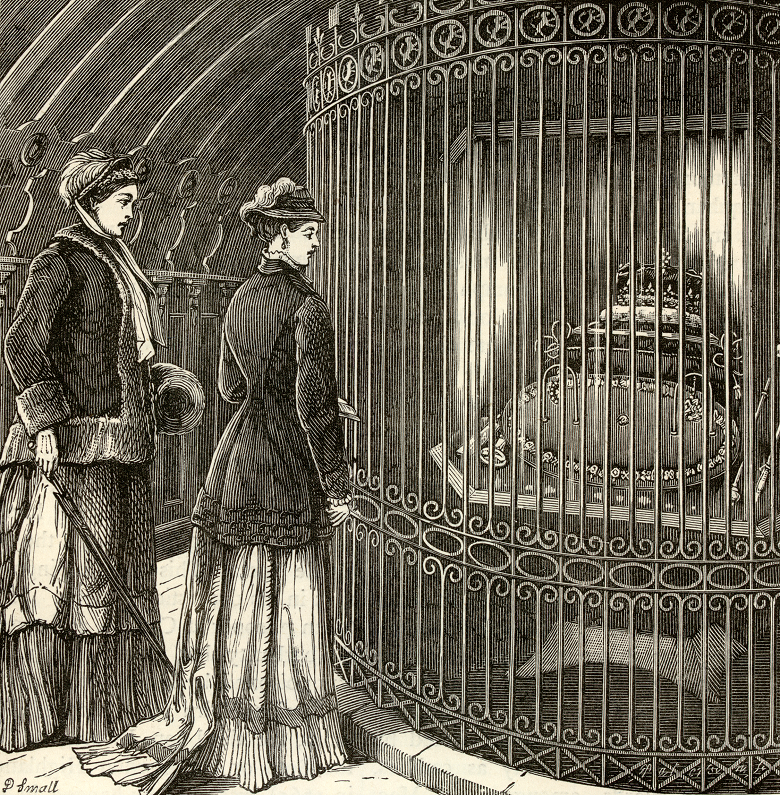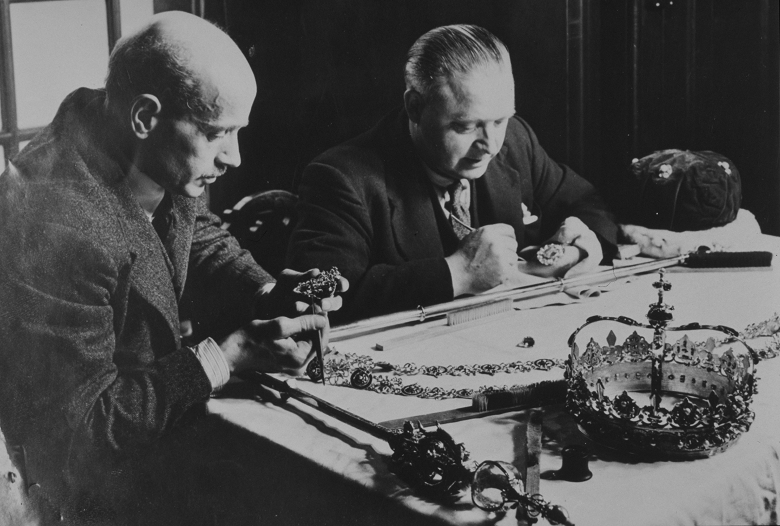One of the first things I learned when I retrained as a conservator after working as a jeweller and gemmologist was that every object has a unique history. An artefact’s ‘biography’ is just as important to understand as what materials it might be made of. Researching an object’s history is often one of the most interesting parts of conservation. It can reveal so many details that might otherwise be missed. Never has this been truer than when working with the Crown of Scotland!
The Honours Conservation Project
From November 2022 to November 2023, the Honours Conservation Project has sought to research, analyse, and conserve the Honours of Scotland. These are Scotland’s crown jewels, and the Crown, Sceptre, and Sword of State are displayed at Edinburgh Castle.
As a conservator who had previously trained as a jeweller and gemmologist, I was excited to look into the history of each of the Honours. This was especially true for the Crown, which has had multiple adaptations, additions, and repairs throughout history.
Uncovering the history of Scotland’s Crown
The history of the Crown has of course been documented before, especially as it is tied so closely to Scotland’s history. What this project allowed me to explore were some of the lesser-known aspects of its construction. It also let me investigate how it had been cared for in the past. These details were invaluable as I developed my understanding of the Crown, especially as I now had the incredible opportunity to join the line of specialists who had cared for it over the years.
The first thing I learned is that the Crown is a very complex and layered object. We know that it was remodelled for King James V in 1540. However, we have very few details about what the Scottish Crown might have looked like before that. However, we do know that parts of this older crown were re-used to create the version we have today.
The work in 1540 was done by the Edinburgh goldsmith John Mosman. He was a member of the Incorporation of Goldsmiths in Edinburgh, a body which would have managed all aspects of their member’s work. This included apprenticeships, standards of workmanship, and hallmarking. Many of these types of incorporations were formed during the medieval period, each specialising in a particular craft. Many jewellers today still learn their trade through studying with master craftspeople, often specialising in one skill until they also gain mastery of it. This traditional method of training, whereby certain techniques are passed down through the centuries with few changes, is part of what drew me to working as a jeweller before I found conservation.
Gold
Mosman was tasked with adding 41 ounces of Scottish gold to the Crown. This gold is understood to have been mined from Crawford Moor in Upper Clydesdale. Much of this gold would have gone in to making the circlet (the base of the Crown). It features a band of alternating Fleurs de Lys and floral crosses. The four arches on top of the circlet were likely taken from the older crown, as were many of the gemstones.
Gemstones
Some of the smallest gems on the Crown are also the most interesting, especially to a gemmologist. Beneath the band of Fleur de Lys are small gold triangles which are alternately set with blue enamel and diamonds. Unlike the diamonds we might see in modern jewellery, these are cut in a very ancient style. The point of the rough diamond is polished down until it is a flat brightly shining surface. This would have been done because the tools for cutting diamonds were extremely limited at the time. In fact, perhaps my favourite stone on the crown is what is called a ‘glossy’ – a rough diamond that is so perfect in its shape and finish that it didn’t need to be cut or polished at all.
Another ancient technique that can be seen on the Crown is the use of foiled stones. These are perfectly clear stones which have been backed with coloured foils in order to enhance their appearance.
There are several examples of foiled stones on the circlet. Some of my favourites include a stone with a beautiful gold-coloured foil backing and another with a complex pink and green foil, which gives it the appearance of a watermelon tourmaline. When combined with the precious amethysts and garnets set into the circlet, the range of colours is dazzling.
Enamel and pearls
One of the most interesting additions made by Mosman in 1540 was the addition of the blue celestial globe that sits on top of the Crown. This globe is topped by a cross decorated with pearls and a large amethyst.
Both the globe and the cross are believed to have been purchased from Paris, where specialised craftsmen had perfected the technique of decorating with coloured enamels. The globe and cross are actually separate pieces, which join together and are fastened to the Crown itself by a hand-cut screw.
A tumultuous history
Given the fragility of some components of the Crown, it really is amazing that it’s still in such good condition. A century after its remodelling, the crown – along with the rest of the Honours – was embroiled in one of the most tumultuous periods in both Scottish and British history. Following the execution of Charles I in 1649 and the abolition of the monarchy, Oliver Cromwell marched on Scotland. His mission was to supress support for the deceased king’s son, also called Charles.

A portrait of Oliver Cromwell. This is a copy of a portrait by Robert Walker. © National Galleries of Scotland. Licensed via Scran.
Cromwell had already seized and destroyed the English Crown Jewels. Fearing the same fate awaited their Scottish counterparts, the Honours were removed for safekeeping before Cromwell captured Edinburgh Castle. It’s possible that the Privy Council of Scotland initially hid them at Stirling Castle.
The Honours of Scotland were used at the Scottish coronation of Charles II at Scone in 1651. After this, they were moved to Dunnottar Castle for their safety. During a further siege, they were smuggled out of Dunnottar Castle and hidden at nearby Kinneff Kirk.
After the restoration of the monarchy in 1660, the Crown and the rest of the Honours returned to Edinburgh. They continued to be used for ceremonial openings of Parliament until 1707. However, after the Act of Union, they were no longer required. They were then locked away in a wooden chest in the Crown Room at Edinburgh Castle. Here they would remain for over 100 years until 1818, when they were rediscovered by Walter Scott.

The Crown Room at Edinburgh Castle in 1882. © Edinburgh City Libraries. Licensed via Scran.
The condition of the Crown
The Crown has managed to survive for over 500 years due to the care and protection it was given. However, there are still signs of small areas of damage that likely stem from its turbulent past.
A description in 1707 notes that some pearls had been lost from the Crown. This damage was noted again in 1889, when Alexander Brook wrote a thorough description of all the Honours for the Society of Antiquaries. This report by Brook gives us an in-depth look at their condition at that time. It is an invaluable record for assessing the state of the Crown today.
Making repairs
After the Honours were rediscovered by Scott, the care of the crown was once again entrusted to Edinburgh jewellers. By looking through letters and receipts in the Historic Environment Scotland archives, we get a good picture of the care of the crown over the last 130 years. We can see that the crown was checked over and cleaned once a year by these skilled craftsmen. We also know occasional repairs were carried out. For example, in 1937 the decision was made to replace the missing pearls on the Crown. The jeweller carefully marked where he had added new pearls by annotating Brook’s illustrations from 1889.
This illustration was especially interesting to discover. If you look closely at the crown you may be able to identify where the more modern pearls have been set. This is because before the early 1900’s only natural pearls were available. Natural pearls displayed a beautiful range of shapes, sizes, and even colours. Soon after 1900 techniques were developed for culturing pearls. This allowed jewellers to standardise the size and shape of the pearls they were using. Nowadays, we’re perhaps more familiar with perfectly round, symmetrical white cultured pearls. We can see these were used for the repair work in 1937.
X-ray specs!
Beyond looking to the archives for hints about the history of the crown, we’ve also been able to take advantage of modern analytical techniques, including X-raying the crown. This has helped us to identify and map out the different materials that have been used for repairs throughout its history. Precious metals like gold and silver have been used, but so have iron and steel. With the help of the HES Science Team we also conducted X-ray fluorescence. This enabled us to identify that the circlet of Scottish gold added by Mosman is an impressive 21 carat!

The Honours being cleaned in 1957. © Crown Copyright reproduced courtesy of Historic Scotland. Licensed by Scran.
Our analysis of the Honours is ongoing. Each detail that we reveal helps illustrate the many hands that took part in making the Crown. They also expose how it has been cared for over the centuries.
One of my favourite parts of this project has been finding these traces of the craftspeople and specialists who have contributed to the history of the crown. It is a reminder that I am only one person in a long line that has been given the opportunity to help preserve the crown. I’m now a small part of its story that will continue on into the future.

